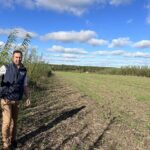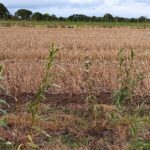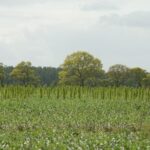LIVING LAB 7: United Kingdom
Cockle Park Farm (research and demonstration farm)
Managed by James Standen
General information
Cockle Park Farm is one of Newcastle University’s practical learning and research farms. It is a 307-hectare (ha) mixed farm situated 18 miles north of Newcastle, of which 20 ha is dedicated to agroforestry. James Standen has been the Farms Director at Newcastle University Farms since 2017; there are 8.5 full time employees working across the two farms at the University.
James Standen came to Cockle Park farm with experience managing farms at other educational institutions as well as having family (his grandfather) in the farming sector. The challenge of making the farm financially viable whilst introducing more sustainable farming techniques was the main aim of taking on the role as Farms Director.
In the past the farm used intensive inversion tillage practices and had a dairy herd primarily bred for show. After 2017, a conservation agriculture approach was introduced with direct drilling across the farm and a more diversified rotation. The dairy system was converted to being primarily forage-based, with the 250 dairy cows now grazed outside more than they are kept inside. There are pigs on the farm too and cash crops including cereals and oilseed rape.
An increase in the diversity of cropping was a priority at Cockle Park Farm. Bi-cropping of the forage whole crop and the introduction of spring cropping has all been done to increase the diversity of crop species on the farm. Spring cropping in the rotation is also being used to reduce the grass weed issues at the farm. The lack of storage on the farm limits the range of crops that can be currently used as well as there being climatic limitations to what can be grown.
Following discussions with academics at the University, a decision to dedicate a large field (20 ha) to agroforestry was made. Willow was chosen as one of tree species because there is a long history of willow production for biomass at the farm with an established willow coppice block planted 23 years ago. This block has developed a highly diverse understory of legumes, flowers and orchids demonstrating the potential of willow to promote in-field diversity. Willow also can provide a reliable income stream for the agroforestry project. In the future agroforestry plots with top fruit may be established.
General farming approach
Conventional farming
Objectives
- To be one of several research projects exploring sustainable farming practices at Cockle Park – using a grazing system for the dairy herd, (making them stand out amongst other universities who have their cows inside year-round), diversifying the cropping system, including more spring cropping in the rotation to reduce grass weed issues as well giving more flexibility in the spring with new research projects, bi-cropping the forage whole crop, and out-wintering cattle on forage crops.
- Creating a biofuel from willow biomass from a block of well-established willow trees, planted 23 years ago. Using this block to optimise yield predictions using satellite and drone technology.
- Building an agroforestry research programme including a trials field with willow and poplar coppice, with the goal of generating income from the agroforestry strips as well as using them for research purposes.
- To eventually introduce top fruit into the agroforestry system so that the produce can be used by Stu Brew (Stu Brew is a student society at Newcastle University that produces beer and other novelty drinks) to produce cider/perry and juice.
Challenges
- The challenges faced at Cockle Park Farm include creating an income stream that can support the project. The lack of coordinated policy and stewardship schemes for agroforestry in the UK means there isn’t the financial support for projects such as this; existing schemes for arable fields have limitations in being applied to agroforestry systems.
- There is a lack of established agroforestry systems in the UK, especially systems that are more mature (5 to 7 years old), as well as systems at a larger scale such as at Cockle Park Farm. This means there is a gap in knowledge and expertise within agroforestry research compared to other agricultural research areas. As Cockle Park Farm agroforestry system is just becoming established after only a few years, it still hasn’t generated answers to all the agronomic and economic questions that are being asked of them.
- When looking for advice before setting up the agroforestry system at Cockle Park farm, it was hard to find experts in planting willow for biomass. The advice gained wasn’t suited to their farm situation.
Research goals
Preliminary monitoring has focused on soil properties, biodiversity, invertebrates and mammals. LiDAR (Light Detection and Ranging) readings have been used on the willow and poplar plots to estimate biomass; disease incidence in the beans was assessed in 2023.
One of the agronomic research questions that Cockle Park farm is addressing is in relation to the management of crops in the alleys. Such as, when using a fungicide, how do the trees in the agroforestry system affect the timings of fungicide application and what is the variation like between the rows? Also, what impacts will trees have on nutrient supply and how will pests be affected – will they decrease or increase?
Another research question the farm would like to investigate is how the the soil properties vary over wet and dry periods due to the trees and how this in turn affects soil workability.
The lack of well-established and larger scale agroforestry systems in the UK means there isn’t a lot of data on the economics of agroforestry plots. Records on the costs, time and inputs of the agroforestry field have been collected over the past two years which includes yield data of the arable crops. As the trees will be harvested every three years, it will take several years to get the results and several cycles of willow and poplar harvesting before conclusions can be drawn.
The University and Farms Director hope that their research will help new and existing large scale agroforestry projects make more informed decisions. The workshops held by the REFOREST North of England Living Lab will facilitate these discussions as well as help identify the issues facing agroforestry in this area and what is needed to address these, in some cases using models such as FarmTree, the Public Goods Tool, and ecosystem service analysis.
Design of the agroforestry system
The agroforestry system at Cockle Park is a 20 ha silvoarable system that was established in spring 2022. The trees cover an area of approximately 3 ha in total, established as strips with four rows of trees (two double rows; 4.6 m wide) separated by 24 m alleys for arable cropping.
The distance between the tree rows is 0.6m, there are two double rows of trees with a gap between each block being 1.7m. The field is set up as an experiment using a randomised complete block design. Each block has an area planted to willow strips, an area planted to poplar strips, and an area of ‘control’ strips which are 4.6 m wide with no trees planted. These control strips are planted with a permanent flowering understory.
The inter-row areas will be cropped following the farm’s typical arable rotation which consists of cereals rotated with break crops of faba beans or oilseed rape and periodic grass/clover ley phases. There is an aspiration to graze the ley phases if fencing can be organised. The trees will be harvested on a normal schedule of every 3-4 years.
Monitoring
At Cockle Park farm University researchers are monitoring soil properties, biodiversity, invertebrates and mammals as well as LiDAR readings on the willow and poplar biomass. These studies are determined by the research questions identified by the students for their dissertation project every year. The farm routinely measures arable yields in the strips / replicated blocks.
No biodiversity or carbon assessments are planned for the Cockle Park farm agroforestry plots as part of REFOREST, but the site has been setup using the FarmTree model and scenarios will be explored with students and researchers to illustrate the potential impacts of variations in management and future climate scenarios.
 Loading...
Loading...

UK, Cockle Park Farm, Newcastle University, Ulgham, Morpeth, Northumberland, NE61 3EA

18 ha

Silvoarable

Cereals, oilseed rape, forages for the cattle, pasture/leys

1 year (planted spring 2022)

Inter-row/In-row distance: 24m/0.6m
Width of tree strips: 4.6m

The field has a total of 3 ha of trees (in a 20-ha field) planted in strips that consist of two double rows of trees with 60-70 cm between each pair of rows and 1.7 m between the double rows. This makes a total width for the tree strip of 4.6m. The inter-row distance between the alleyways is 24m.

Mixed: livestock (dairy, pigs) and arable crops

Livestock: Dairy cattle and pigs; 250 in dairy cattle herd










